Preparation and Characterization of Self-Healing Polyurethane Powder Coating Using Diels–Alder Reaction
Abstract
:1. Introduction
2. Materials and Methods
2.1. Synthesis of the DA Adducts
2.2. Preparation of the Powder Coating
2.3. Film Properties and Characterization
3. Results and Discussion
3.1. Thermal Gravimetry Analysis (TGA)
3.2. Differential Scanning Calorimetry (DSC)
3.3. Rheological Measurements
3.4. Coating Properties Measurements
3.5. Depth-Sensing Nano-Indentation (DSI)
3.6. Roughness Measurement
3.7. Scandisk Confocal Microscope (SCM)
3.8. Scanning Electron Microscopy (SEM)
3.9. DSC Measurement Coupled with Camera
4. Conclusions
Author Contributions
Funding
Institutional Review Board Statement
Informed Consent Statement
Data Availability Statement
Acknowledgments
Conflicts of Interest
Appendix A
References
- White, S.R.; Sottos, N.R.; Geubelle, P.H.; Moore, J.S.; Kessler, M.R.; Sriram, S.; Brown, E.N.; Viswanathan, S. Autonomic healing of polymer composites. Nature 2001, 409, 794–797. [Google Scholar] [CrossRef] [PubMed]
- Guimard, N.K.; Oehlenschlaeger, K.K.; Zhou, J.; Hilf, S.; Schmidt, F.G.; Barner-Kowollik, C. Current trends in the field of self-healing materials. Macromol. Chem. Phys. 2012, 213, 131–143. [Google Scholar] [CrossRef]
- Blaiszik, B.; Sottos, N.; White, S. Nanocapsules for self-healing materials. Compos. Sci. Technol. 2008, 68, 978–986. [Google Scholar] [CrossRef]
- Blaiszik, B.; Caruso, M.; McIlroy, D.; Moore, J.; White, S.; Sottos, N. Microcapsules filled with reactive solutions for self-healing materials. Polymer 2009, 50, 990–997. [Google Scholar] [CrossRef]
- Nakahata, M.; Takashima, Y.; Yamaguchi, H.; Harada, A. Redox-responsive self-healing materials formed from host–guest polymers. Nat. Commun. 2011, 2, 511. [Google Scholar] [CrossRef] [Green Version]
- Gragert, M.; Schunack, M.; Binder, W.H. Azide/Alkyne-“Click”-Reactions of Encapsulated Reagents: Toward Self-Healing Materials. Macromol. Rapid Commun. 2011, 32, 419–425. [Google Scholar] [CrossRef] [PubMed]
- Rahman, M.A.; Sartore, L.; Bignotti, F.; Di Landro, L. Autonomic self-healing in epoxidized natural rubber. ACS Appl. Mater. Interfaces 2013, 5, 1494–1502. [Google Scholar] [CrossRef] [PubMed]
- Liu, Y.-L.; Chuo, T.-W. Self-healing polymers based on thermally reversible Diels–Alder chemistry. Polym. Chem. 2013, 4, 2194–2205. [Google Scholar] [CrossRef]
- Canadell, J.; Goossens, H.; Klumperman, B. Self-healing materials based on disulfide links. Macromolecules 2011, 44, 2536–2541. [Google Scholar] [CrossRef]
- Imato, K.; Natterodt, J.C.; Sapkota, J.; Goseki, R.; Weder, C.; Takahara, A.; Otsuka, H. Dynamic covalent diarylbibenzofuranone-modified nanocellulose: Mechanochromic behaviour and application in self-healing polymer composites. Polym. Chem. 2017, 8, 2115–2122. [Google Scholar] [CrossRef]
- Liu, J.; Xiao, C.; Tang, J.; Liu, Y.; Hua, J. Construction of a Dual Ionic Network in Natural Rubber with High Self-Healing Efficiency through Anionic Mechanism. Ind. Eng. Chem. Res. 2020, 59, 12755–12765. [Google Scholar] [CrossRef]
- Farshchi, N.; Gedan-Smolka, M. Polyurethane powder coatings: A review of composition and characterization. Ind. Eng. Chem. Res. 2020, 59, 15121–15132. [Google Scholar] [CrossRef]
- Giles, S.L.; Heller, N.W.; Clayton, C.R.; Walker, M.E.; Wytiaz, M.J.; Wynne, J.H. Novel methods of producing low-reflectance coatings utilizing synergistic effects of polymer phase separation. ACS Appl. Mater. Interfaces 2016, 8, 26251–26257. [Google Scholar] [CrossRef] [PubMed]
- Holzmann, D.; Schöfberger, W.; Holzinger, D.; Schmidt, T.; Knör, G. Functional nanoscale additives for ultra-durable powder-coating polymers. Mon. Für Chem. -Chem. Mon. 2011, 142, 855–860. [Google Scholar] [CrossRef]
- Zouari, M.; Kharrat, M.; Dammak, M.; Barletta, M. Scratch resistance and tribological performance of thermosetting composite powder coatings system: A comparative evaluation. Surf. Coat. Technol. 2015, 263, 27–35. [Google Scholar] [CrossRef]
- Gedan-Smolka, M.; Lehmann, F.; Lehmann, D. Low Temperature Curing Uretdione Powder Coating Systems; Powder Coating Europe: Nurnberg, Germany, 2002. [Google Scholar]
- Gedan-Smolka, M.; Lehmann, F.; Lehmann, D. New catalysts for the low temperature curing of uretdione powder coatings. In Proceedings of the 28′th International Waterborne, High Solids, & Powder Coatings Symposium, New Orleans, LA, USA, 29 January 2001; pp. 405–419. [Google Scholar]
- Torres Hernández, F.; Gámez-Montaño, R. Synthesis of Epoxyisoindolinones Via Microwave-assisted Ugi-4C/Intramolecular-Diels-Alder Reaction. In Proceedings of the 24th International Electronic Conference on Synthetic Organic Chemistry; MDPI: Basel, Switzerland, 2020. [Google Scholar] [CrossRef]
- Ha, Y.; Kim, Y.; Jung, Y. Rapid and Local Self-Healing Ability of Polyurethane Nanocomposites Using Photothermal Polydopamine-Coated Graphene Oxide Triggered by Near-Infrared Laser. Polymers 2021, 13, 1274. [Google Scholar] [CrossRef] [PubMed]
- Craven, J.M. Cross-Linked Thermally Reversible Polymers Produced from Condensation Polymers with Pendant Furan Groups Cross-Linked with Maleimides. US3435003A, 25 March 1969. [Google Scholar]
- Park, J.S.; Darlington, T.; Starr, A.F.; Takahashi, K.; Riendeau, J.; Hahn, H.T. Multiple healing effect of thermally activated self-healing composites based on Diels–Alder reaction. Compos. Sci. Technol. 2010, 70, 2154–2159. [Google Scholar] [CrossRef]
- Lee, H.-Y.; Cha, S.-H. Enhancement of self-healing property by introducing ethylene glycol group into thermally reversible Diels-Alder reaction based self-healable materials. Macromol. Res. 2017, 25, 640–647. [Google Scholar] [CrossRef]
- Chen, X.; Dam, M.A.; Ono, K.; Mal, A.; Shen, H.; Nutt, S.R.; Sheran, K.; Wudl, F. A thermally re-mendable cross-linked polymeric material. Science 2002, 295, 1698–1702. [Google Scholar] [CrossRef] [PubMed]
- Chen, X.; Wudl, F.; Mal, A.K.; Shen, H.; Nutt, S.R. New thermally remendable highly cross-linked polymeric materials. Macromolecules 2003, 36, 1802–1807. [Google Scholar] [CrossRef]
- Jasiński, R. Searching for zwitterionic intermediates in hetero diels–alder reactions between methyl α, p-dinitrocinnamate and vinyl-alkyl ethers. Comput. Theor. Chem. 2014, 1046, 93–98. [Google Scholar] [CrossRef]
- Jasiński, R.; Kubik, M.; Łapczuk-Krygier, A.; Kącka, A.; Dresler, E.; Boguszewska-Czubara, A. An experimental and theoretical study of the hetero Diels–Alder reactions between (E)-2-aryl-1-cyano-1-nitroethenes and ethyl vinyl ether: One-step or zwitterionic, two-step mechanism? React. Kinet. Mech. Catal. 2014, 113, 333–345. [Google Scholar] [CrossRef] [Green Version]
- Pratama, P.A.; Sharifi, M.; Peterson, A.M.; Palmese, G.R. Room temperature self-healing thermoset based on the Diels–Alder reaction. ACS Appl. Mater. Interfaces 2013, 5, 12425–12431. [Google Scholar] [CrossRef]
- Araya-Hermosilla, R.; Pucci, A.; Raffa, P.; Santosa, D.; Pescarmona, P.P.; Gengler, R.Y.; Rudolf, P.; Moreno-Villoslada, I.; Picchioni, F. Electrically-responsive reversible Polyketone/MWCNT network through Diels-Alder chemistry. Polymers 2018, 10, 1076. [Google Scholar] [CrossRef] [Green Version]
- Bai, J.; He, Q.; Shi, Z.; Tian, M.; Xu, H.; Ma, X.; Yin, J. Self-assembled elastomer nanocomposites utilizing C60 and poly (styrene-b-butadiene-b-styrene) via thermally reversible Diels-Alder reaction with self-healing and remolding abilities. Polymer 2017, 116, 268–277. [Google Scholar] [CrossRef]
- Magana, S.; Zerroukhi, A.; Jegat, C.; Mignard, N. Thermally reversible crosslinked polyethylene using Diels–Alder reaction in molten state. React. Funct. Polym. 2010, 70, 442–448. [Google Scholar] [CrossRef]
- Chen, J.; Luo, K.; Zhu, J.; Yu, J.; Wang, Y.; Hu, Z. Reversibly cross-linked fullerene/polyamide composites based on Diels-Alder reaction. Compos. Sci. Technol. 2019, 176, 9–16. [Google Scholar] [CrossRef]
- Okhay, N.; Jegat, C.; Mignard, N.; Taha, M. PMMA thermoreversible networks by Diels–Alder reaction. React. Funct. Polym. 2013, 73, 745–755. [Google Scholar] [CrossRef]
- Du, P.; Liu, X.; Zheng, Z.; Wang, X.; Joncheray, T.; Zhang, Y. Synthesis and characterization of linear self-healing polyurethane based on thermally reversible Diels–Alder reaction. RSC Adv. 2013, 3, 15475–15482. [Google Scholar] [CrossRef]
- Ritzen, L.; Montano, V.; Garcia, S.J. 3D Printing of a Self-Healing Thermo-plastic Polyurethane Through FDM: From Polymer Slab to Mechanical Assessment. Polymers 2021, 13, 305. [Google Scholar] [CrossRef]
- Du, P.; Wu, M.; Liu, X.; Zheng, Z.; Wang, X.; Sun, P.; Joncheray, T.; Zhang, Y. Synthesis of linear polyurethane bearing pendant furan and cross-linked healable polyurethane containing Diels–Alder bonds. New J. Chem. 2014, 38, 770–776. [Google Scholar] [CrossRef]
- Cheng, X.; Peng, C.; Zhang, D.; Liu, S.; Zhang, A.; Huang, H.; Lian, J. A facile method for the preparation of thermally remendable cross-linked polyphosphazenes. J. Polym. Sci. Part A Polym. Chem. 2013, 51, 1205–1214. [Google Scholar] [CrossRef]
- Duval, A.; Couture, G.; Caillol, S.; Avérous, L. Biobased and aromatic reversible thermoset networks from condensed tannins via the Diels—Alder reaction. ACS Sustain. Chem. Eng. 2017, 5, 1199–1207. [Google Scholar] [CrossRef]
- Du, P.; Wu, M.; Liu, X.; Zheng, Z.; Wang, X.; Joncheray, T.; Zhang, Y. Diels–Alder-based crosslinked self-healing polyurethane/urea from polymeric methylene diphenyl diisocyanate. J. Appl. Polym. Sci. 2014, 131. [Google Scholar] [CrossRef]
- Dolci, E.; Froidevaux, V.; Michaud, G.; Simon, F.; Auvergne, R.; Fouquay, S.; Caillol, S. Thermoresponsive crosslinked isocyanate-free polyurethanes by D iels-A lder polymerization. J. Appl. Polym. Sci. 2017, 134. [Google Scholar] [CrossRef]
- Feng, L.; Yu, Z.; Bian, Y.; Lu, J.; Shi, X.; Chai, C. Self-healing behavior of polyurethanes based on dual actions of thermo-reversible Diels-Alder reaction and thermal movement of molecular chains. Polymer 2017, 124, 48–59. [Google Scholar] [CrossRef]
- Chen, S.; Wang, F.; Peng, Y.; Chen, T.; Wu, Q.; Sun, P. A Single Molecular Diels–Alder Crosslinker for Achieving Recyclable Cross-Linked Polymers. Macromol. Rapid Commun. 2015, 36, 1687–1692. [Google Scholar] [CrossRef]
- Yu, S.; Zhang, R.; Wu, Q.; Chen, T.; Sun, P. Bio-Inspired high-performance and recyclable cross-linked polymers. Adv. Mater. 2013, 25, 4912–4917. [Google Scholar] [CrossRef]
- Rong, M.Z.; Zhang, M.Q. Self-healing polyurethane elastomer with thermally reversible alkoxyamines as crosslinkages. Polymer 2014, 55, 1782–1791. [Google Scholar]
- Yamaguchi, M.; Ono, S.; Terano, M. Self-repairing property of polymer network with dangling chains. Mater. Lett. 2007, 61, 1396–1399. [Google Scholar] [CrossRef]
- Ling, J.; Rong, M.Z.; Zhang, M.Q. Photo-stimulated self-healing polyurethane containing dihydroxyl coumarin derivatives. Polymer 2012, 53, 2691–2698. [Google Scholar] [CrossRef]
- Ying, H.; Zhang, Y.; Cheng, J. Dynamic urea bond for the design of reversible and self-healing polymers. Nat. Commun. 2014, 5, 3218. [Google Scholar] [CrossRef]
- Xu, Y.; Chen, D. A novel self-healing polyurethane based on disulfide bonds. Macromol. Chem. Phys. 2016, 217, 1191–1196. [Google Scholar] [CrossRef]
- Wouters, M.; Craenmehr, E.; Tempelaars, K.; Fischer, H.; Stroeks, N.; van Zanten, J. Preparation and properties of a novel remendable coating concept. Prog. Org. Coat. 2009, 64, 156–162. [Google Scholar] [CrossRef]
- Lehmann, D.; Hupffer, B.; Gedan-Smolka, M.; Bräuer, M.; Nagel, J.; Edelmann, M. Material-Plastic Composite and Method for the Manufacture Thereof. WO 2010/015612, 11 February 2010. [Google Scholar]
- Gramlich, W.M.; Robertson, M.L.; Hillmyer, M.A. Reactive compatibilization of poly (l-lactide) and conjugated soybean oil. Macromolecules 2010, 43, 2313–2321. [Google Scholar] [CrossRef]
- Lin, C.; Ge, H.; Wang, T.; Huang, M.; Ying, P.; Zhang, P.; Wu, J.; Ren, S.; Levchenko, V. A self-healing and recyclable polyurethane/halloysite nanocomposite based on thermoreversible Diels-Alder reaction. Polymer 2020, 206, 122894. [Google Scholar] [CrossRef]
- Liu, X.; Du, P.; Liu, L.; Zheng, Z.; Wang, X.; Joncheray, T.; Zhang, Y. Kinetic study of Diels–Alder reaction involving in maleimide–furan compounds and linear polyurethane. Polym. Bull. 2013, 70, 2319–2335. [Google Scholar] [CrossRef]
- Roush, W.R.; Sciotti, R.J. Enantioselective total synthesis of (−)-chlorothricolide via the tandem inter-and intramolecular Diels− Alder reaction of a hexaenoate intermediate. J. Am. Chem. Soc. 1998, 120, 7411–7419. [Google Scholar] [CrossRef]
- Ayats, J.C.; Fischer, H.; van Benthem, R. Stereoisomeric effects in thermo-remendable polymer networks based on diels-alder crosslink reactions. J. Polym. Sci. Part A Polym. Chem. 2010, 48, 3456–3467. [Google Scholar]
- Mestry, S.; Mhaske, S. Synthesis of epoxy resins using phosphorus-based precursors for flame-retardant coating. J. Coat. Technol. Res. 2019, 16, 807–818. [Google Scholar] [CrossRef]

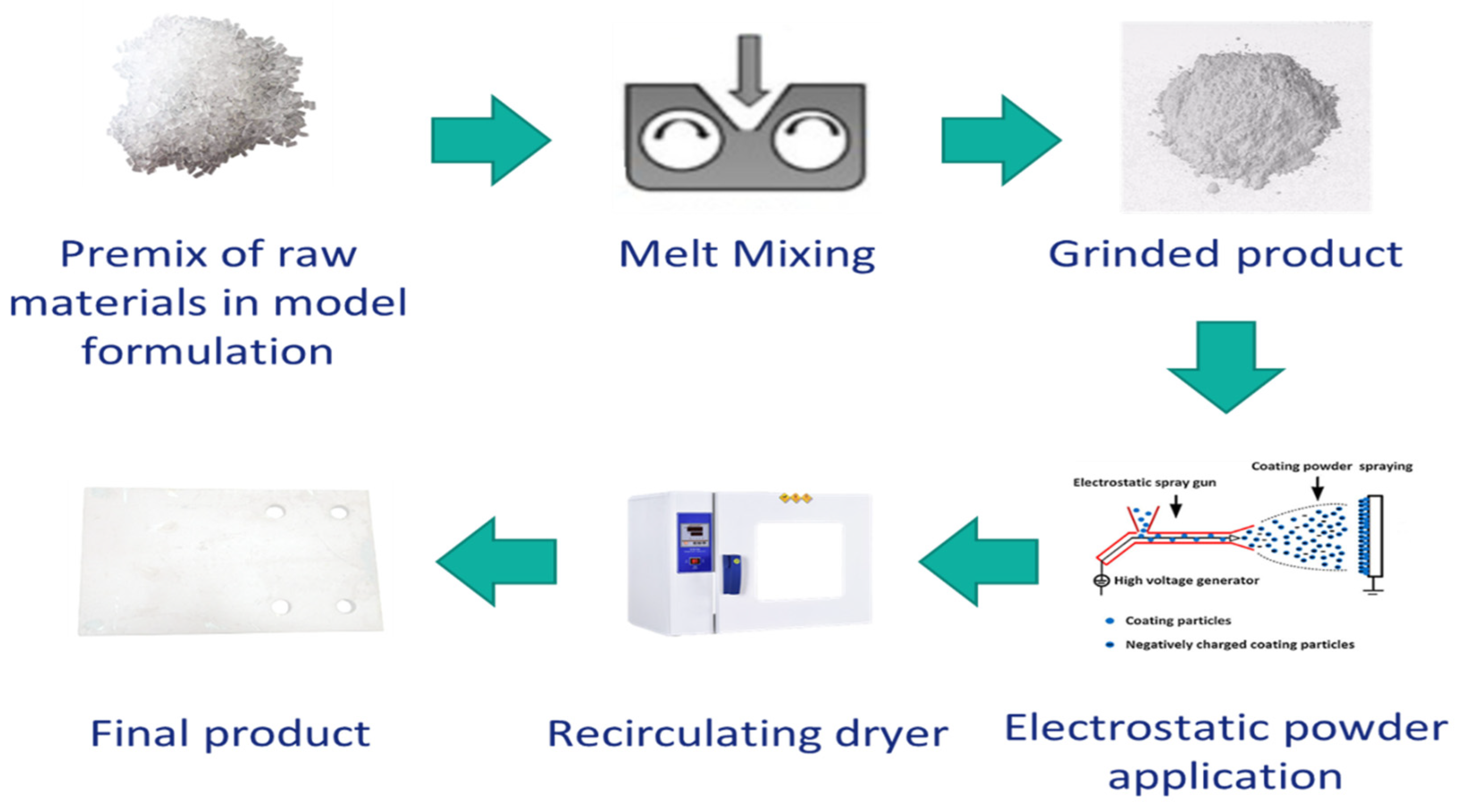
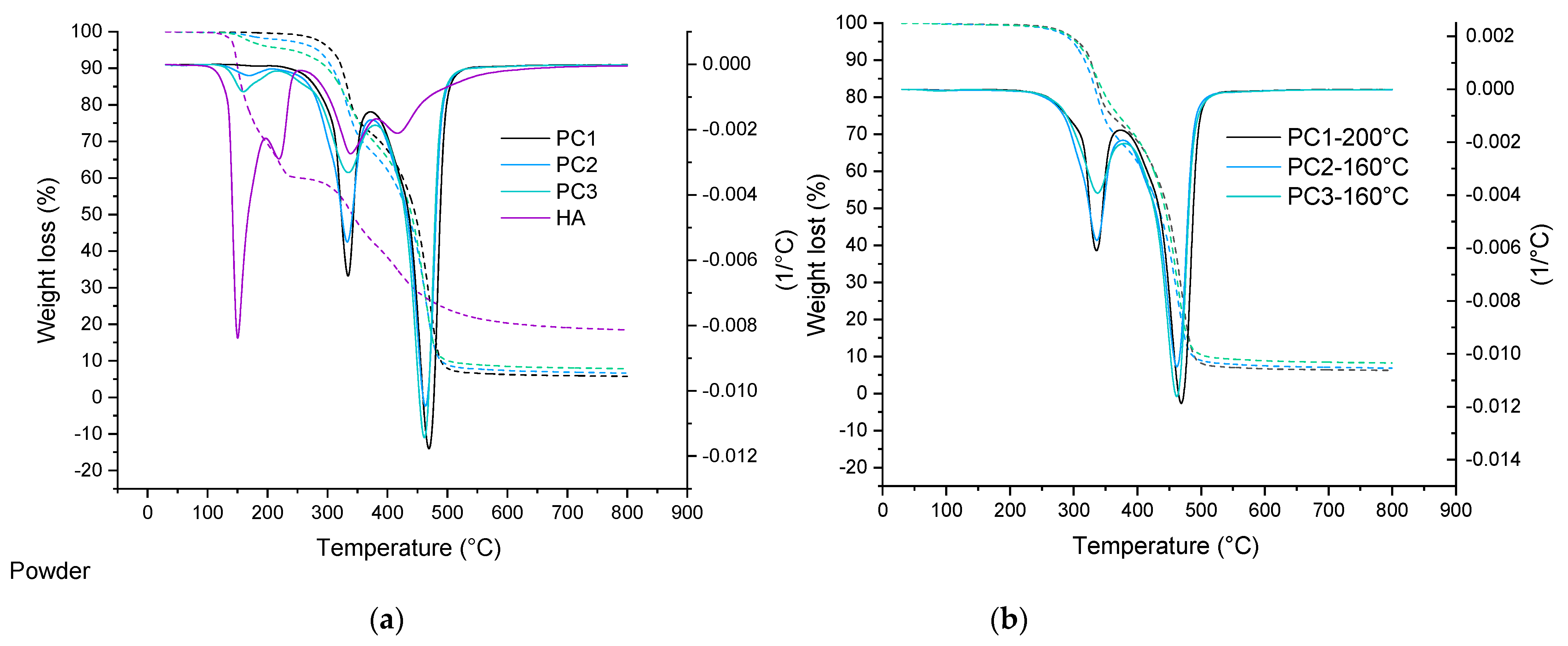


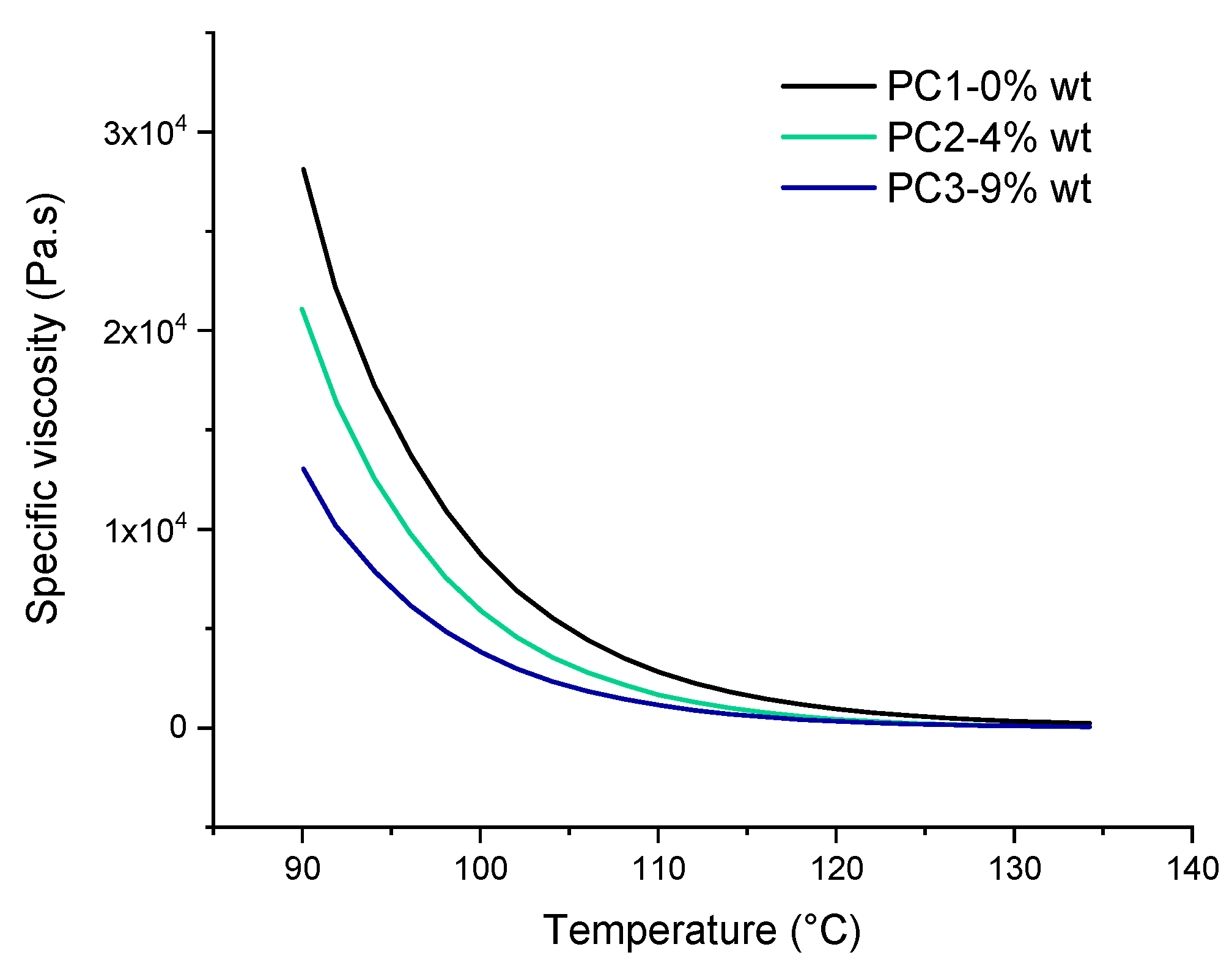

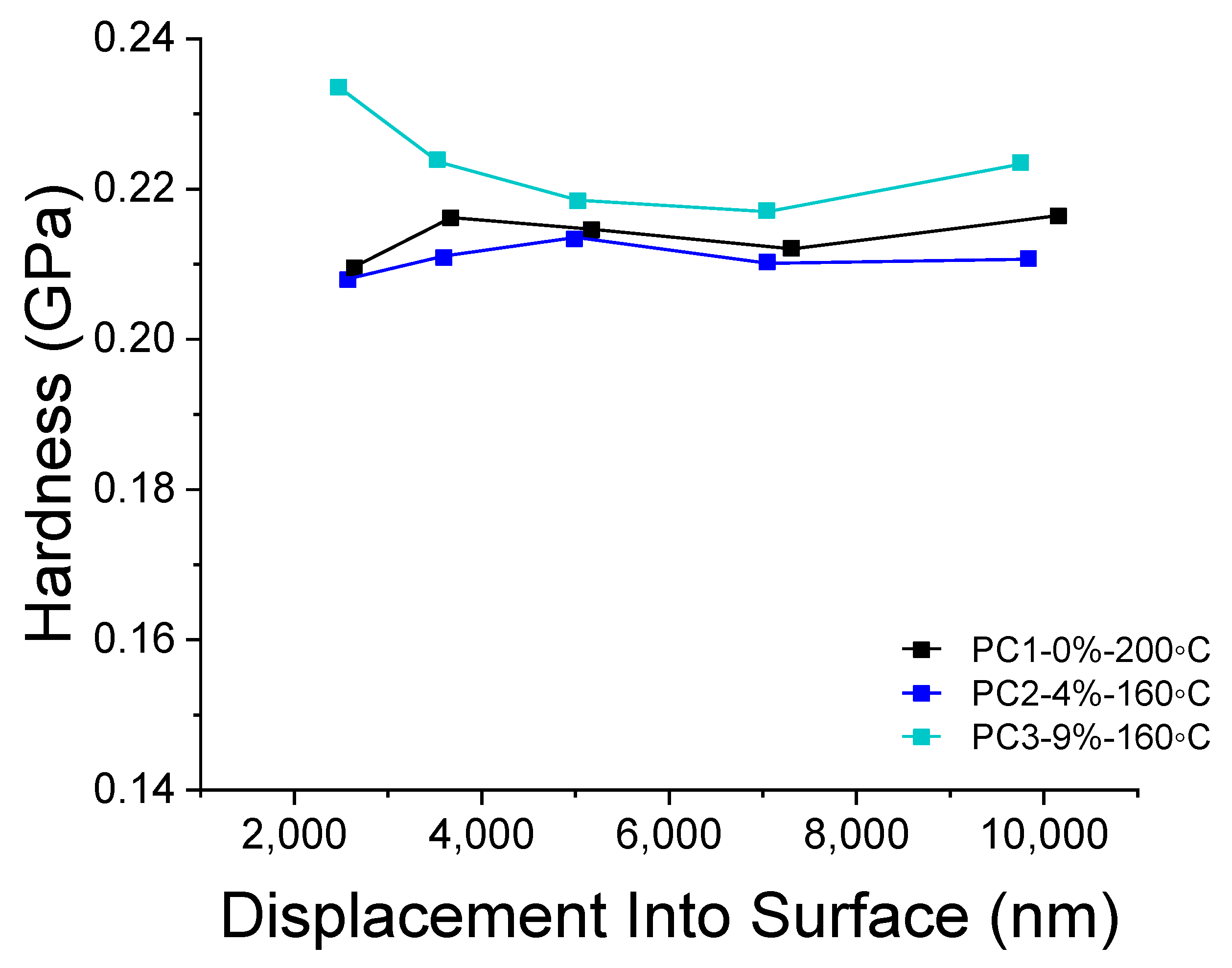

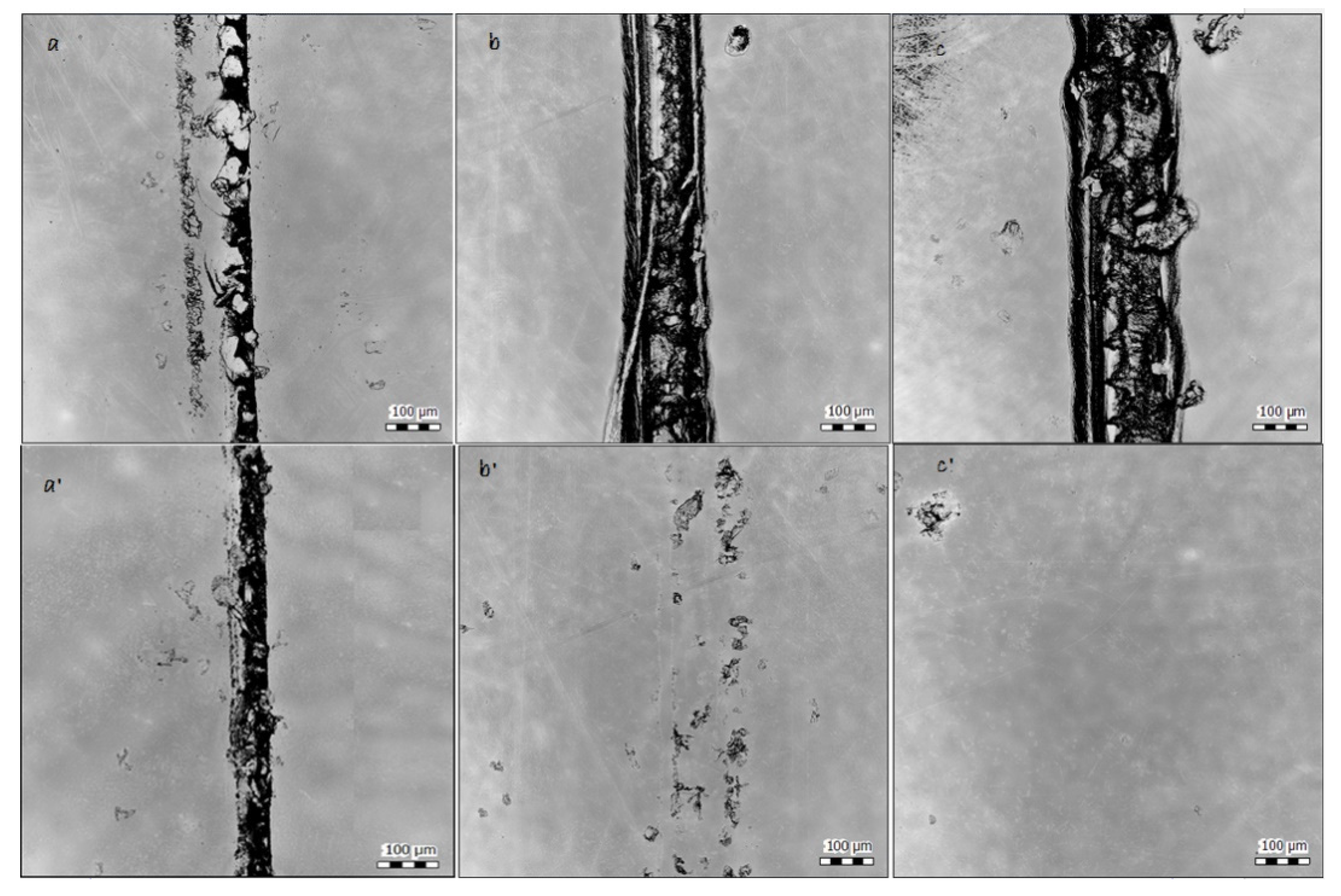
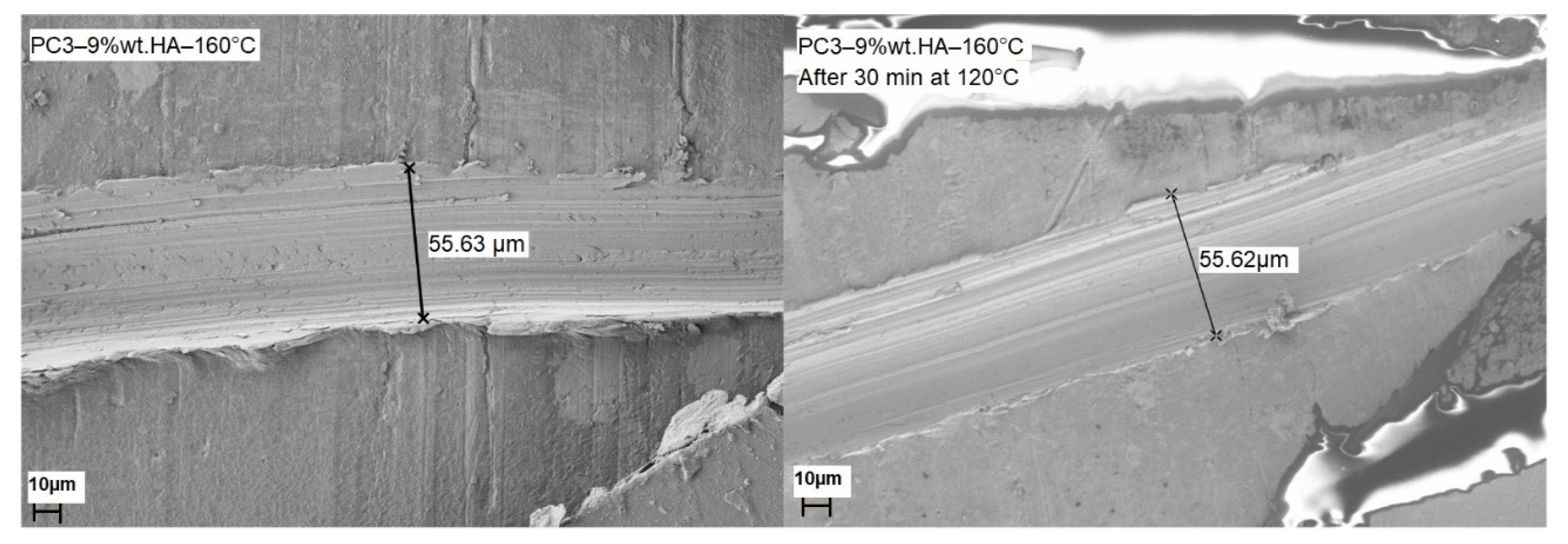

| Sample | Healing Agent (% wt.) | Uncured Powder | Cured Film | Difference after Curing | ||
|---|---|---|---|---|---|---|
| Weight Loss (%) | Temperature (°C) | Weight Loss (%) | Temperature (°C) | |||
| PC1 | 0% | 1 | 255.16 | 1 | 255.66 | 0.5 ↑ |
| 0.3967 | 200 | 0.4000 | 200 | 0.0033 ↑ | ||
| 0.1986 | 160 | 0.3230 | 160 | 0.1244 ↑ | ||
| PC2 | 4% | 1 | 166 | 1 | 237.33 | 71.33 ↑ |
| 1.9131 | 200 | 0.6458 | 200 | −1.2673 ↓ | ||
| 0.8036 | 160 | 0.4373 | 160 | −0.3663 ↓ | ||
| PC3 | 9% | 1 | 150.16 | 1 | 244.66 | 94.5 ↑ |
| 4.0425 | 200 | 0.5850 | 200 | −3.4575 ↓ | ||
| 1.7843 | 160 | 0.4449 | 160 | −1.3394 ↓ | ||
| Tg (°C) | Powder | Cured Film at 160 °C | |||
|---|---|---|---|---|---|
| Sample | 1st Heating | 2nd Heating | 1st Heating | 2nd Heating | |
| PC1–0% wt. | 57.27 | 75.26 | 73.51 | 75.85 | |
| PC2–4% wt. | 48.82 | 71.73 | 56.1 | 74.75 | |
| PC3–9% wt. | 85.36 | 32.26 | 53.49 | 72.07 | |
| Sample | Curing Temperature (°C) | Waviness | Gloss (GU) | Impact Test at 160 (inchxlb) * | |||
|---|---|---|---|---|---|---|---|
| LW | SW | 20° | 60° | 85° | |||
| PC1–0% wt. | 80 | NM | NM | 5.9 | 1.7 | 0.4 | F |
| 120 | NM | NM | 63.9 | 100 | 53.8 | F | |
| 160 | 50.9 | 30.8 | 109 | 133 | 35.2 | F | |
| 200 | 51.6 | 36.4 | 80.9 | 107 | 76.5 | P | |
| PC2–4% wt. | 80 | NM | NM | 17.2 | 37.9 | 24.4 | F |
| 120 | 38 | 35.9 | 159 | 155 | 97.7 | F | |
| 160 | 22.6 | 20.9 | 159 | 158 | 95.2 | P | |
| 200 | 20.7 | 20.7 | 123 | 138 | 93.5 | P | |
| PC3–9% wt. | 80 | NM | NM | 17.4 | 53.6 | 50.9 | F |
| 120 | 27.1 | 17.5 | 114 | 125 | 95.6 | F | |
| 160 | 26.5 | 23.2 | 126 | 134 | 97.6 | P | |
| 200 | 22.5 | 10.6 | 80.1 | 110 | 88.1 | P | |
| Sample | Width (µm) | Maximum Height (µm) | Mean Height (µm) |
|---|---|---|---|
| PC1–0% wt.–200 °C | 94.9 | 2.02 | 1.75 |
| PC2–4% wt.–160 °C | 94.9 | 25.0 | 24.9 |
| PC3–9% wt.–160 °C | 94.9 | 29.5 | 24.6 |
Publisher’s Note: MDPI stays neutral with regard to jurisdictional claims in published maps and institutional affiliations. |
© 2021 by the authors. Licensee MDPI, Basel, Switzerland. This article is an open access article distributed under the terms and conditions of the Creative Commons Attribution (CC BY) license (https://creativecommons.org/licenses/by/4.0/).
Share and Cite
Farshchi, N.; Gedan-Smolka, M.; Stommel, M. Preparation and Characterization of Self-Healing Polyurethane Powder Coating Using Diels–Alder Reaction. Polymers 2021, 13, 3803. https://doi.org/10.3390/polym13213803
Farshchi N, Gedan-Smolka M, Stommel M. Preparation and Characterization of Self-Healing Polyurethane Powder Coating Using Diels–Alder Reaction. Polymers. 2021; 13(21):3803. https://doi.org/10.3390/polym13213803
Chicago/Turabian StyleFarshchi, Negin, Michaela Gedan-Smolka, and Markus Stommel. 2021. "Preparation and Characterization of Self-Healing Polyurethane Powder Coating Using Diels–Alder Reaction" Polymers 13, no. 21: 3803. https://doi.org/10.3390/polym13213803
APA StyleFarshchi, N., Gedan-Smolka, M., & Stommel, M. (2021). Preparation and Characterization of Self-Healing Polyurethane Powder Coating Using Diels–Alder Reaction. Polymers, 13(21), 3803. https://doi.org/10.3390/polym13213803






